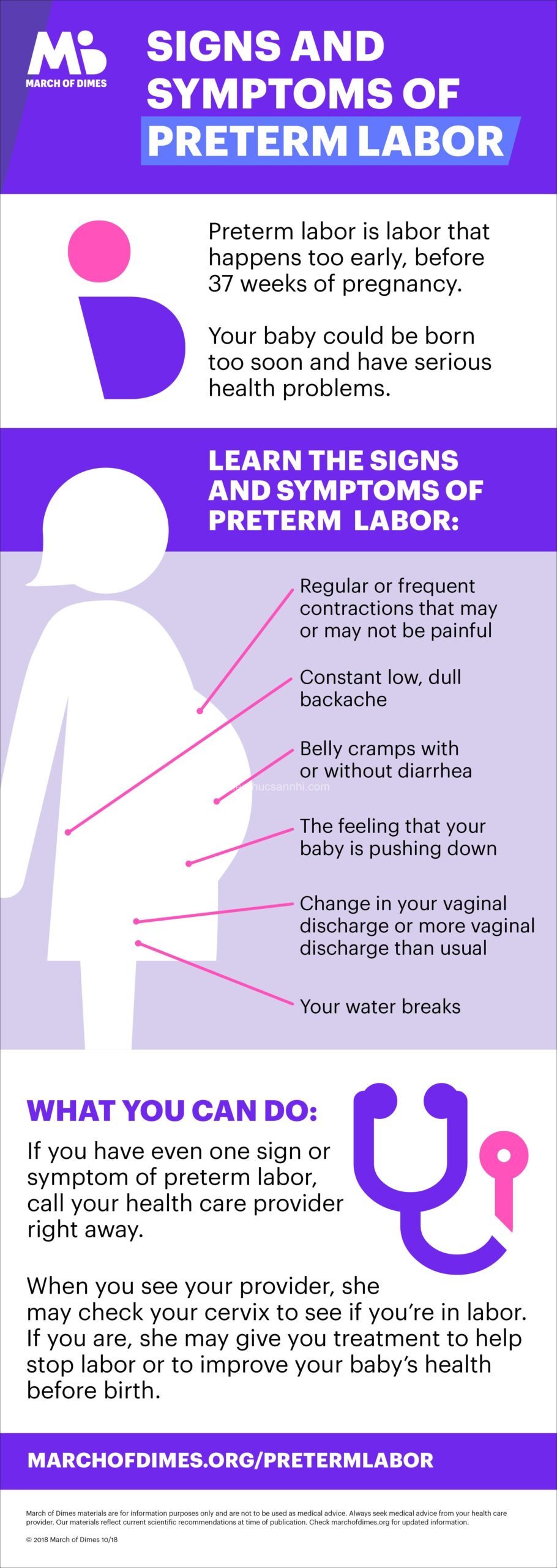
Preterm Labor Signs: Recognizing & Seeking Help – Kienthucsannhi.com. In today’s article, kienthucsannhi.com will explore with you in the most detailed and complete way. See now!
Recognizing the Warning Signs of Preterm Labor
Preterm labor is a serious condition that can happen when a baby is born before 37 weeks of pregnancy. It’s essential for expectant mothers to be aware of the potential signs and symptoms, as early intervention can often improve outcomes for both mother and baby. While not every woman experiences preterm labor, it’s vital to be prepared and know what to look for.
Here are some of the most common signs of preterm labor:
- Increased Vaginal Discharge: If you notice a sudden increase in vaginal discharge, especially if it’s watery, bloody, or has a foul odor, it could be a sign of preterm labor. This is because the amniotic sac, which contains the baby, may be leaking. This is a key indicator that your baby is ready to come early, so it’s important to consult your doctor immediately.
- Pelvic Pressure or Cramping: A persistent feeling of pressure in your pelvis, coupled with cramping, can also be a sign of preterm labor. This is often caused by contractions, which are the tightening and relaxing of the muscles in the uterus.
- Backache: A persistent backache that’s different from the usual pregnancy aches can be another sign of preterm labor. This pain is often related to the contractions, which are working to open the cervix and prepare the body for labor.
- Uterine Contractions: More than four contractions per hour, lasting at least 30 seconds each, can be a warning sign. These contractions can be irregular or regular, and they may feel like a tightening or hardening in the abdomen.
- Water Breaking: A sudden gush of fluid from your vagina may indicate that your water has broken, which can occur during preterm labor. It’s important to contact your doctor immediately to determine if it’s amniotic fluid.
- Other Potential Signs: While less common, other signs to watch out for include abdominal pain or tenderness, diarrhea or nausea, feeling tired or weak, and increased vaginal bleeding.
When to Contact Your Doctor
If you experience any of the signs mentioned above, it’s crucial to contact your doctor immediately. They can assess your situation and determine if you are experiencing preterm labor. Even if you’re not sure, it’s always better to be safe than sorry. Early diagnosis and intervention can significantly improve the chances of a healthy pregnancy and delivery.
Risk Factors for Preterm Labor
While the exact cause of preterm labor is often unknown, certain factors can increase the risk. These include:
- Previous Preterm Births: If you’ve had a preterm birth previously, you’re more likely to experience it again.
- Multiple Pregnancies: Carrying twins or more increases the risk of preterm labor.
- Certain Medical Conditions: Conditions like diabetes, high blood pressure, or infections during pregnancy can also increase the risk.
- Smoking, Alcohol, and Drug Use: These habits can also contribute to preterm labor.
Understanding the Causes and Potential Complications
The exact causes of preterm labor are still not fully understood. It’s often a complex combination of factors, both genetic and environmental. However, research suggests that factors like:
- Preterm Labor – Cause – Unknown: Many cases of preterm labor have no known cause.
- Preterm Labor – Cause – Multiple Pregnancies: Carrying multiples puts extra stress on the uterus and can lead to preterm labor.
- Preterm Labor – Cause – Previous Preterm Birth: Women who have had preterm births previously are more likely to experience it again.
- Preterm Labor – Cause – Smoking: Smoking during pregnancy can damage blood vessels and increase the risk of preterm labor.
- Preterm Labor – Cause – Infections: Infections during pregnancy, especially those affecting the uterus or cervix, can increase the risk of preterm labor.
Preterm labor can have various complications for both mother and baby, including:
- Premature Birth – Risk – Complications for baby: A baby born prematurely may have difficulty breathing and developing, potentially leading to long-term health issues.
- Premature Birth – Risk – Complications for mother: Mothers may experience postpartum complications, such as bleeding or infections.
- Low Birth Weight – Risk – Complications for baby: Babies born prematurely are often underweight, increasing their vulnerability to health problems.
- Respiratory Problems – Risk – Complications for baby: Babies born preterm are at increased risk of breathing difficulties due to underdeveloped lungs.
- Brain Bleeds – Risk – Complications for baby: Premature babies are more susceptible to brain bleeds, potentially leading to developmental delays or disabilities.
- Developmental Delays – Risk – Complications for baby: Premature babies may experience developmental delays in areas like language, motor skills, and cognition.
Seeking Treatment and Management
If preterm labor is diagnosed, your doctor will recommend a treatment plan based on your specific situation.
- Preterm Labor – Treatment – Medications: Medications like tocolytics can be used to help stop contractions and buy time for the baby’s lungs to mature.
- Preterm Labor – Treatment – Bed Rest: Bed rest can sometimes be helpful, particularly in the early stages of preterm labor.
- Preterm Labor – Treatment – Delivery: If the pregnancy can’t be maintained safely, your doctor will recommend delivery, often by Cesarean section.
- Preterm Labor – Treatment – Corticosteroids: Corticosteroids, administered to the mother, can help the baby’s lungs mature, reducing the risk of respiratory problems after birth.
Prevention Strategies to Lower the Risk
While some risk factors for preterm labor cannot be controlled, several steps can be taken to reduce the risk.
- Preterm Labor – Prevention – Healthy Lifestyle: Maintaining a healthy weight, eating a balanced diet, and getting regular exercise can help.
- Preterm Labor – Prevention – Prenatal Care: Regular prenatal appointments are crucial for early detection and management of any issues.
- Preterm Labor – Prevention – Avoiding Smoking: Smoking during pregnancy is extremely harmful and can increase the risk of preterm labor.
- Preterm Labor – Prevention – Managing Health Conditions: Managing existing medical conditions like diabetes or high blood pressure can also help.
- Preterm Labor – Prevention – Taking Prenatal Vitamins: Taking prenatal vitamins ensures that you’re getting the essential nutrients your body needs during pregnancy.
- Preterm Labor – Prevention – Avoiding Strenuous Activities: Avoid strenuous activities and lifting heavy objects, as these can increase the risk of preterm labor.
Staying Informed and Supporting Your Health
It’s essential to understand the potential risks and complications associated with preterm labor. However, it’s important to remember that with early detection and proper medical care, many mothers and babies experience healthy pregnancies and successful deliveries.
If you have any questions or concerns about preterm labor, please consult your doctor or other healthcare providers.
For more information, visit the resources mentioned above, or visit https://kienthucsannhi.com/ where you can find a wealth of information on all things related to pregnancy and baby care.
Don’t forget to interact with us! Leave your comments below, share this post, and continue to explore the amazing world of pregnancy and childbirth. Together, we can empower mothers to make informed decisions and ensure the best possible outcomes for their babies.

Frequently Asked Questions About Preterm Labor
What are the common signs and symptoms of preterm labor?
- Preterm Labor – Symptoms – Contractions: Contractions are a common sign of preterm labor, but they may not be the same as contractions in full-term labor. Preterm contractions may be more irregular and less painful.
- Preterm Labor – Symptoms – Backache: A persistent backache, even if it’s not related to contractions, can be a sign of preterm labor.
- Preterm Labor – Symptoms – Vaginal Discharge: Changes in vaginal discharge, especially if it’s watery, bloody, or has a foul odor, can be a sign of preterm labor.
- Preterm Labor – Symptoms – Pelvic Pressure: A feeling of pressure in your pelvis, especially if it’s accompanied by cramping, can be a sign of preterm labor.
- Preterm Labor – Symptoms – Water Breaking: If your water breaks before 37 weeks of pregnancy, this is considered preterm labor.
When should I contact my doctor about preterm labor?
If you experience any of the signs and symptoms of preterm labor, it’s important to contact your doctor immediately. It’s always better to err on the side of caution and get checked out.
What are some of the risk factors for preterm labor?
- Preterm Labor – Risk factors – Multiple Pregnancies: Carrying twins or more increases the risk of preterm labor.
- Preterm Labor – Risk factors – Previous Preterm Birth: If you have had a preterm birth previously, you are at a higher risk of having another.
- Preterm Labor – Risk factors – Smoking: Smoking during pregnancy is a major risk factor for preterm labor.
- Preterm Labor – Risk factors – Infections: Infections during pregnancy, especially those affecting the uterus or cervix, can increase the risk of preterm labor.
- Preterm Labor – Risk factors – Certain Medical Conditions: Conditions like diabetes, high blood pressure, or certain autoimmune disorders can increase the risk of preterm labor.
How is preterm labor treated?
- Preterm Labor – Treatment – Medications: Medications like tocolytics can be used to help stop contractions and buy time for the baby’s lungs to mature.
- Preterm Labor – Treatment – Bed Rest: Bed rest may be recommended to help slow or stop contractions.
- Preterm Labor – Treatment – Delivery: If the pregnancy can’t be maintained safely, your doctor will recommend delivery, often by Cesarean section.
- Preterm Labor – Treatment – Corticosteroids: Corticosteroids, administered to the mother, can help the baby’s lungs mature, reducing the risk of respiratory problems after birth.
What can I do to help prevent preterm labor?
- Preterm Labor – Prevention – Healthy Lifestyle: Maintaining a healthy weight, eating a balanced diet, and getting regular exercise can help reduce the risk.
- Preterm Labor – Prevention – Prenatal Care: Regular prenatal appointments are crucial for early detection and management of any issues.
- Preterm Labor – Prevention – Avoiding Smoking: Smoking during pregnancy is extremely harmful and can increase the risk of preterm labor.
- Preterm Labor – Prevention – Managing Health Conditions: Managing existing medical conditions like diabetes or high blood pressure can also help.
- Preterm Labor – Prevention – Taking Prenatal Vitamins: Taking prenatal vitamins ensures that you’re getting the essential nutrients your body needs during pregnancy.
- Preterm Labor – Prevention – Avoiding Strenuous Activities: Avoid strenuous activities and lifting heavy objects, as these can increase the risk of preterm labor.
Conclusion
Knowing the signs of preterm labor and seeking medical attention promptly can significantly improve the chances of a healthy pregnancy and delivery. I hope this information has been helpful and informative for you. Remember to stay informed, consult your healthcare provider, and never hesitate to seek help if you have any concerns. For more insightful information and resources, be sure to visit Kienthucsannhi.com and explore our valuable content.





